The Bonner Springs Shale derives its' name from Bonner Springs, Wyandotte County, Kansas, where the type section was located in the Lone Star Cement Company Quarry (Newell, 1932, p. 93). Its average thickness in Kansas is about 20 feet (6 m), but it may reach 60 feet (19 m) locally. The Bonner Springs Shale ranges in thickness from about 8 to 10 feet (2.5 m -3.2 m) in the Lower Platte River Valley in Cass and Sarpy counties, Nebraska. In Nebraska, the unit consists of gray to yellow shale, slightly sandy shale with plant fossils in the lower part (Whitcomb, 1966). The upper foot (0.3 m) may contain slabby limestone that contains a diverse, near shore marine fauna near Cedar Creek, Nebraska, east of Louisville. West of Louisville, the limestone at the top of the Bonner Springs Shale is dolomitized (calcium carbonate altering to calcium magnesium carbonate), and most of the marine fossils have been destroyed by this natural process. Whitcomb (1966) described in detail several localities of Bonner Springs outcrops in the Lower Platte River Valley, and in northeastern Kansas.
The late W. D. "Ted" White of Omaha made some of the earliest collections of fossils from the Bonner Springs Shale from the quarries near Cedar Creek, and Mr. White led this writer, Roger Pabian, and his paleontology professor, J. A. Fagerstrom, and fellow student, John Boellstorff, to the site. The site proved to be important for the abundance of fossils it provided, and several papers on fossil communities (Fagerstrom, 1964), trilobite biometrics (Pabian and Fagerstrom, 1968), and brachiopod evolution (Fagerstrom and Boellstorff, 1964) resulted from the research completed on fossils from the Bonner Springs Shale by the above authors. More recently, Leighton and Maples (2002) have worked with productoid brachiopods from the Bonner Springs Shale of Cass County, Nebraska.
In the mid continent cyclothemic model proposed by Heckel (19--) and Heckel and Baesemann (19--), the Bonner Springs Shale is a near shore shale, as indicated by the fossil plants near its base and the presence of large, thick-shelled invertebrates near its top. The overlying Merriam Limestone Member of the Plattsburg Formation is probably the transgressive limestone of the overlying cyclothem. Cyclothemic sedimentary deposits are important in the interpretation of late Pennsylvanian and early Permian sedimentary history of the entire North American mid-continent.
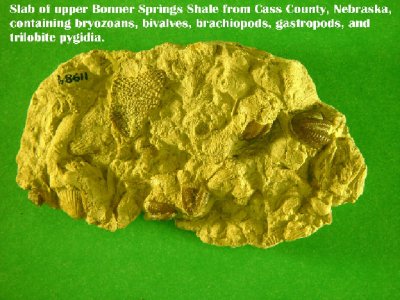
Fossil Slab
Description: The upper 35 cm (12 inches) of the Bonner Springs Shale exposed east of Louisville, Cass County, contains a fossil assemblage that includes bryozoans, brachiopods, bivalves, gastropods, cephalopods, trilobites, and crinoids. The abundance of immature brachiopods in this assemblage led Fagerstrom (1964) to conclude that this interval in the Bonner Springs Shale contained a fossil community.
Echinoderms - Crinoids
Echinoderms from the Bonner Springs Shale are mostly known from loose plates or ossicles. This is likely due to the fact that the Bonner Springs Shale was deposited in a relatively high energy environment in very near shore conditions where wave action and currents were sufficient to break up the exoskeletons that were made up of plates that were attached together by muscuesr or ligaments.
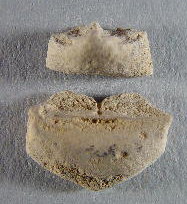
Aglaocrinus sp.
Description: "Aglaocrinus sp." - Radial and primibrachial plates.
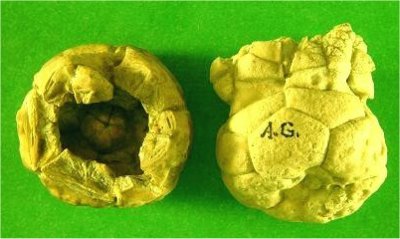
Ethelocrinus sp. cf. magister
Description: "Ethelocrinus sp. cf. magister" (Miller and Gurley) - Summit view of doral cup and anterior view of partial crown.
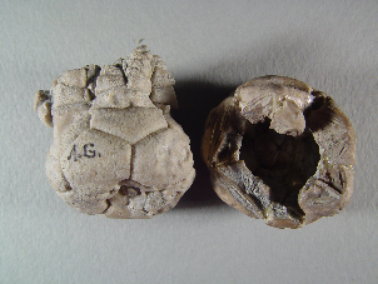
Ethelocrinus sp. cf. magister
Description: "Ethelocrinus sp. cf. magister" (Miller and Gurley) - Summit and basal view of cup.
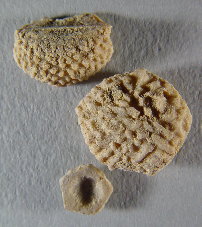
Ethelocrinus sp. cf. magister
Description: "Ethelocrinus sp. cf. magister" (Miller and Gurley) - Infrabasal circlet (below), basal plate, and radial plate (above).
Cnidarians (corals, jellyfish, sea anemones, conularids) from the Bonner Springs Shale

Aglaocrinus sp.
Description: "Aglaocrinus sp." - Radial and primibrachial plates.

Ethelocrinus sp. cf. magister
Description: "Ethelocrinus sp. cf. magister" (Miller and Gurley) - Summit view of doral cup and anterior view of partial crown.

Ethelocrinus sp. cf. magister
Description: "Ethelocrinus sp. cf. magister" (Miller and Gurley) - Summit and basal view of cup.

Ethelocrinus sp. cf. magister
Description: "Ethelocrinus sp. cf. magister" (Miller and Gurley) - Infrabasal circlet (below), basal plate, and radial plate (above).
Class Bivalvia (Clams, Scallops)
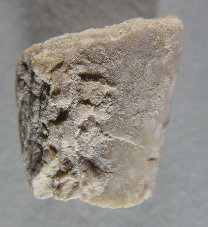
Aviculopinna peracuta
Description: "Aviculopinna peracuta" (Shumard) - Partial shell from approximate mid-section of "Aviculopinna peracutus" (Shumard).
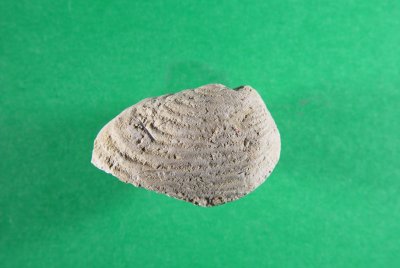
Wilkingia
Description: "Wilkingia terminale" (Hall) (=Allorisma terminale Hall)
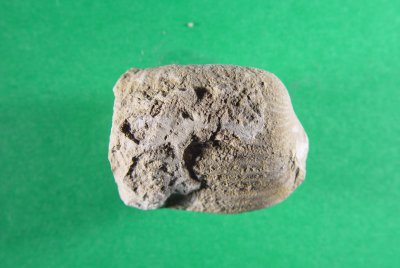
Wilkingia
Description: "Wilkingia terminale" (Hall) (=Allorisma terminale Hall)
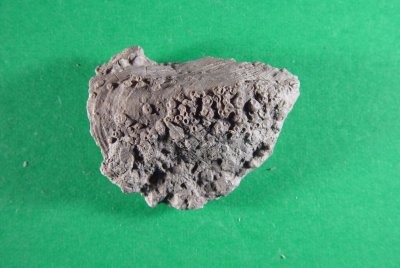
Myalina sp.
Description: "Myalina" - A valve of "Myalina sp." that is heavily encrusted by spirorbid worms.